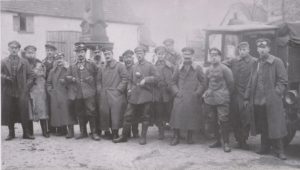
The photos below are snapshots from the 3D program used to create the master figure and a colourized version of the original photo. It is not a bad attempt to get the original colours of uniform and equipment right. The leather jacket M1907 could be a little darker and the service dress underneath with more grey, but apart from that it gives much life to these characters.
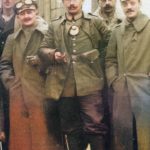
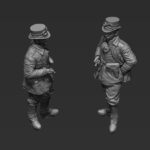
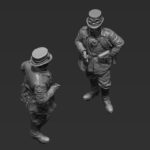
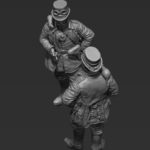
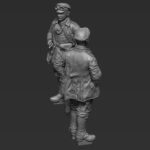
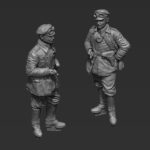
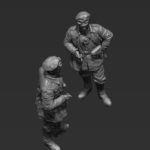
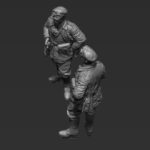
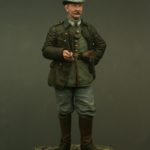
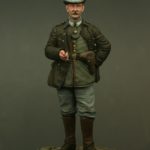
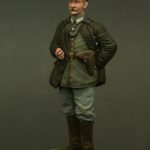
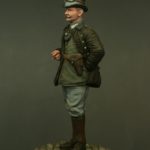
Figure painted by Günther Sternberg, Germany
Figure – Prussian Motor Transport Corps Driver, 1915 – Pr. Kraftfahrer 1915
- Scale / Maßstab: 1/32nd (54mm)
- Approx. height of figure/ ca. Höhe Figur: 54mm
- Material: Resin
- Parts / Teile: 10
- Infosheet / Infoblatt: English
- Code / Artikel-Nr.: 38MTH
- Attention: Not a toy. Model kit or model making accessories – not suitable for children under 14 years of age. / Achtung: Kein Spielzeug. Modellbauzubehör – nicht für Kinder unter 14 Jahren geeignet
GPSR Data / Angaben
- Manufacturer / Hersteller: Jon Smith Modellbau
- Responsible Person / Verantwortliche Person
- Address: Hannoverstr. 68, 29664 Walsrode, Germany
- Contact / Kontakt: info@jonsmith-modellbau.com
- Tel: +49 (0)5161 8255
Contents Figure / Inhalt Figur:
- Head with Top Hat and Flying Goggles/ Kopf mit Zylinder und Fliegerbrille
- 2nd Alternative Head with Field Cap M1908 with Flying Goggles / 2. Alternativ-Kopf mit Feldmütze M1908 und Fliegerbrille
- Upper Body / Oberkörper
- 2nd Alternative Upper Body with Rat / 2. Alternativ–Oberkörper mit Ratte
- Right Arm with Hand and Cigar / Rechte Arm with Hand mit Zigarre
- Left Arm with Hand / Rechte Arm with Hand
- Right Leg with Boot / Rechte Bein mit Stiefel
- Left Leg with Boot / Linke Bein mit Stiefel
- Pistol 08 / Pistole 08
- Figure Base / Figur-Sockel
The Shoulder Rat is an option.
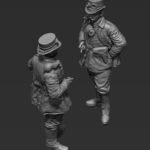
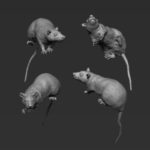
About this Figure
The figure depicts a member of the Prussian Motor Driver Battalion, or Kraftfahrer – ca. 1915. At the outbreak of the war in 1914 Prussia had just one Motor Driver Battalion and in the Bavaria State just a company. As opposed to the German Transport Units, or Train, which were solely equipped with horse-drawn vehicles and dealt with supply, the Motor Driver units were responsible for motorized transportation of all kinds and were also to take on patrolling and dispatch (messenger) duties. Within the first months of hostilities, the driver units were expanded so that by spring 1915 each Army Corps and independent Division had its own Kraftwagen-Kolonne, incl. a motor cycle unit.
During the autumn of 1917 over half of the newly appointed German Tank Unit’s personnel was formed from Motor Driver troops, many carrying out the more technical roles such as drivers and mechanics. On many photos of captured British tanks put into German service and their own A7v panzers, one can often see crewmen still wearing parts of their original leather Kraftfahrer uniforms.
Top Hat (also known as a, beaver hat, chimney pot hat, high hat, silk hat, cylinder hat, or stove pipe hat): Worn from the latter part of the 18th to mid-20th century and generally associated with upper class, professional males for daytime and evening dress. Traditionally made from cheesecloth, linen, flannel and shellac, the shell being covered with a black silk plush (other fabrics were used in place of the expensive silk). The early types around 1830s were extremely tall, with the height reduced towards the end of the 19th century. The hatband was attached to the bottom of cylinder, which was later replaced by ribbed silk.
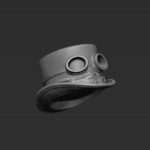
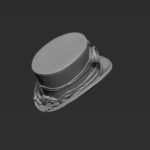
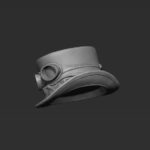
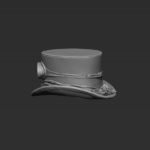
This is the only photograph that I have seen of the top hat combined with a World War 1 military uniform. One can only assume that the hat is being worn just for the group photograph. Traditionally, top hats were still being worn by coach drivers at the beginning of the 20th century in Germany, particularly in larger towns and cities, including the addition of coloured hat bands. Maybe he brought it along, or found in locally?
During the research and design stage of this figure project it was not possible to solve the mystery of the large cloth or hatband. There was a time when mourning bands were placed around top hats at funerals, hanging down at the rear in various lengths, although these were black in colour and comprised of much less cloth. A cloth cover or holder for the goggles may be the explanation, but here again I believe this is not the case as most of these items came in small leather bags. It could just be a piece of cloth added by the soldier for decoration purpose and offers a chance to brighten-up the otherwise darker / drab military colours of this figure subject. Any suggestions regarding this subject or about the figure would be very much welcomed.
Goggles / Fliegerbrille: The driving or flying goggles were standard issue to drivers, but as with the leather jackets and field caps, there were numinous versions.
It is also possible to add imitation glass lenses to the goggles after painting is completed. Here one could use Micro Kristal Klear, or similar products to produce a clear film within the outer resin rings. Alternatively, one can produce the glass lenses by using a clear plastic or similar. I used the Micro Kristal Klear on the spectacles for German Prisoner bust.
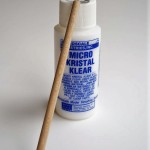
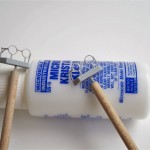
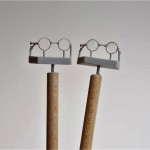
Field Cap M1908 for Other Ranks / Dienstmütze mit Schirm für Mannschaften M1908: Issued to other ranks of the Train (Transport), Medical and Mountain units and was basically a Field Cap M1907 with a blackened leather visor and chin-strap added. The chinstrap at each side had black metal or grey painted buttons (in some instances Neusilber = copper, zinc & nickel). The cap band was in black with red piping above and on outer edge of top. From late 1915 early 1916, the peaks and chin-straps were issued in grey.
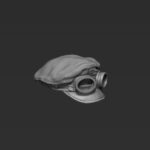
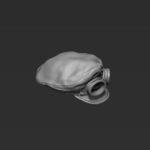
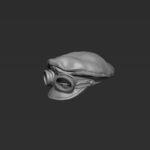
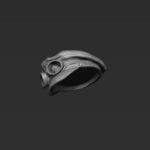
From spring 1917 onwards the peak and chinstrap were no longer made from leather, but an Ersatz material, either vulcanised fibre or treated card, both finished in a matt grey tone. In October 1918 is was decided to discontinue the M1908 cap and the visor and chin-strap were to be removed. This is one of the reasons why so few of these caps have survived today.
The two metal Kokarden badges at the front were – top: Die Reichsfarben: black, white and red (from outwards to the centre) and – bottom: Kokarde representing the state where the Unit was raised – e.g. Prussia – Preussen: black, white and black. Bavaria – Bayern: white, light blue and white. Brunswick – Braunschweig: blue, yellow and blue. Hessen – Hessen: white, red and white etc.
In many of the pre- and early war photographs one sees Driver Corps troops wearing the all leather field cap. I decided against this version as the bust and particularly the figure versions would be showing just too much leather.
Neck Band / Halsbinde M1914: Designed to soak up the sweat and at the same time keep the field service dress or overcoat collar clean. Between the overcoat collar and the neck on the figure one can make out the Neck Band M1914. This was the replacement to the M1907 Neck Cloth, a square piece of material, which produced problems when the wearer was marching, actually causing the garment to tighten up around the neck. The neck band on the other hand was smaller and not unlike a detachable shirt collar, with a semi-circle apron of material attached underneath. Colour: these neck bands varied in colour from grey, light- grey to grey- green.
Leather Jacket for Driver Corps M1907 / Lederanzug für Kraftfahrer M1907: Members of the Driver Corps were issued leather uniforms to protect the wearers against the elements whilst driving the often open vehicles of the time. There seems to be a number of differences to these leather jackets with variations principally to the collar, collar-insignia and type and number of buttons used. Most pre and early war photographs show the jackets with the white metal automobile patches on a dark-blue material collar, with nickel or new-silver buttons mounted to a supporting leather strip. Later versions are often without any patches on a blackened leather collar and either metal or larger, darker (possibly bone) buttons.
I have modelled the jacket as near as possible, or what can be determined from the original photograph. Here there is no collar-insignia to be seen on what could either be a leather or cloth collar.
The K on shoulder straps has been modelled slightly higher than would normally be the case. This to assist in the painting. There are also small casting webs placed under the collar and shoulder straps (between pointed end and collar), which can be removed / reduced before painting
Field Service Dress Tunic M1907/10 / Feldrock M1907/10: Underneath the leather jacket he wears the Field Service Dress Tunic M1907/10. This was the main field service dress issued to all foot troops during the first years of the war. It had depending on the unit or home state different variations of cuff and skirt design. Colour: made out of a dark grey material (Jäger, Maschinengewehr and Schützen units wore sometimes a green- grey version). It had a turn down collar, with eight nickel or Tombak (an alloy of copper and zinc, which had a matt bronze/yellow colour) buttons at the front. Although hidden underneath the jacket, the shoulder straps for the Transport Corps were piped (outlined) in grey, with the monogram, or number in red. Red piping also appeared along the front of the tunic, parallel to the buttons and along the skirt decorations at the rear. The outside edge of collar, and the cuffs were piped in black. The collar braid left and right are white with black in the centre of each chevron.
Leather Trousers / Lederhose: Made from chrome-tanned calfskin leather with a dark grey wool flannel lining and cut in the same fashion as the Service Dress Trousers. Normally and certainly on earlier versions, the trousers retained the red piping – Vorstoß (Paspelierung) – running down each outer side of the trouser leg. Colour: black leather. Stripe: Ponceau red.
Leather Gaiters M1912 / Leder-Gamaschen M1912: Produced in blackened leather with a strap and buckle at top and hook attachment at bottom (behind flap) to secure around bottom of leg. These gaiters were the standard in combination of the half-boot, but seen less often during the latter part of the war due to supply shortages of leather.
Other Ranks Laced-up Half-Boots / Schnürschuhe für Mannschaften: Issued in black leather, but with no nails on the sole. The eyelets were in metal, with leather and later string laces.
Belt M1895 / Koppel M1895: The original belts were issued in natural brown leather, the buckle in brass with a Neusilber / nickel silver inlay. From 1915, leather equipment was officially issued blackened, buckles painted over in grey or manufactured in steel with a grey finish.
Pistol 08 / P 08 (or Luger – the Germans never called this weapon the Luger – this is an anglicised name): The P 08 was first produced in 1900, with the German military taken it on in 1908 – hence the name Pistole 08. As a service pistol it had its drawbacks, mainly it was expensive, difficult to produce and susceptible to dirt. Colour of holster: blackened leather.
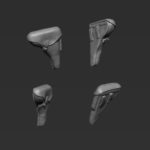
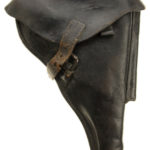
German Dynamo Flashlight / Magnet-Lampe: An interesting and clever device, although probably a little impractical when used other than illumining a map or something similar held directly in front of you. In practice, one sharp pull of the ring will keep the bulb lit for a number of seconds. The lamp had a metal casing, painted in a green, semi-gloss tone, a brown / grey cord for fixing around the wearer’s neck and a metal pull-ring underneath. The clear, convex glass lens covered the bulb.
The original photos shows this flashlight reflecting the light, hence it appears very shiny. The few original items that I have seen show them to be semi-gloss green. The lamp should fit without any adjustments on his chest and partly under the open leather jacket. Trial fitting would be advised, especially when coats of paint have been applied to the figure. One can ease fitting by removing the sharp bottom edge a little. Underneath the pull-ring one could remove some of the resin filling the gap between ring and tunic.
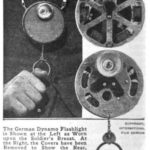
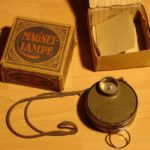
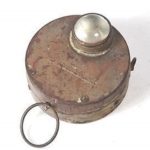
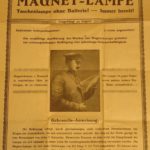
The flashlight is cast directly onto the tunic with the smaller scale figures (1:35th and 1:32nd).
The Rat – Rattus norvegicus:

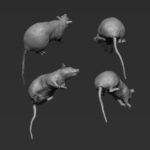
The Common Rat: Actually, when one talks about rats, then there are two best known rat species – the brown rat (Rattus norvegicus) and the black rat (Rattus rattus- also known as the ship rat, roof rat, and house rat). I have chosen to create a set of the larger of the two groups, the brown rat, which is the dominant rat in Europe and much of North America.
The Naming: Originally called the Hanover rat, the brown rat has had many different names throughout history, but is nowadays correctly called Norwegian rat or Norway rat (Latin: Rattus norvegicus). Why it was called this is not certain, as the brown rat did not originate from Norway, or at the time had any brown rat entered this country. Other names include common rat, street rat, sewer rat, brown Norway rat and wharf rat.
Description: These brown or grey rodents will average a body length of up to 25 cm, with a similar tail length. The male rat is larger than the female and can weigh around 300 – 350g, twice as much as the smaller black rat or Rattus rattus. Under good conditions, the brown rat can weigh up to 900 – 1000g, although this is seldom seen. The fir is coarse and usually brown or dark grey in colour, with the underside or belly area a much lighter, or light grey tone. The ears, feet, tip of nose and tail are without fir and will normally have a lighter colour. The eyes are nearly always black without any white showing.
A female rat may breed up to 6 – 7 times a year, with each litter numbering from 2 – 14. The Norway rat is fully grown in approx. 4 weeks and will live up to 3 years. The rats are found anywhere there are people, but particularly in urban areas – this is called commensalism, which means that one species helps another species, without any help in return.
The rat burrow (nest) consists of networks of tunnels and chambers, linked together with passageways. Here they will live together as a group or pack (sometimes called a colony). Rats will cache their food and store within the chambers. The burrows are found in ditches, cellars, sewers, barns, old buildings, woods and marchlands or just anywhere near a food supply (near humans). They will defend their burrow as a group against predators. The brown rat has exceptionally good hearing and is often found near water. They are good climbers, swimmers and have a strong sense of smell. They will normally hunt at night in packs.
The trench systems of the Great War on both sides offered the ideal living conditions for the Norway rat and there is much evidence from soldiers describing their co-habitants.
Predators: The natural predators of rats include the snake, fox, weasel, birds of prey, cat and dog. In the trenches during the Great War, apart from the soldiers, it was the dogs which helped to keep the rat population under control (or as best as possible under the circumstances). It seems that any of the terrier family were quite common as rat killers. There are also many photos of Jack Russells, particularly kept by German troops.
The rat on shoulder is purely my own idea and is not based on any WW1 photograph. Whilst researching for this figure, I had looked at various small items, or add-ons, which would enhance this project, without removing the focus from the figure. During the design stage I only came up with automobile accessories, such as tools, oil cans etc. The shoulder-rat was chosen as an unusual combination to an already odd character wearing the top hat. The rat is of cause optional, but if chosen, will fit (on bust and 1/16th full figure versions) over the right hand shoulder strap, the rear feet sitting slightly underneath and the tail hanging naturally down the back.
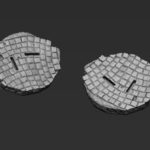
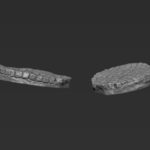
The Base: The base supplied with the figure depicts a piece of cobbled road, popular at the time in rural areas of France & Belgium and can still be found today. Made with local stone and set in a row-pattern, the outer, or edge-stones are larger and follow a straight line, one after the other (not shown on base), bordering the road. Through the natural slight differences in stone sizes, the rows would of cause become off-set. The individual cobbles are flat and smooth on top, but still show an uneven surface on the sides. Depending on the amount of traffic, there will be grass / moss, small weeds etc. growing between the stones, particularly near the edges and in gaps / dips within the road surface.
 An deutschsprachige Interessenten:
Sie können mich per eMail oder Telefon auch gerne auf deutsch kontaktieren. Ortsbesuch ist nach Absprache möglich.
An deutschsprachige Interessenten:
Sie können mich per eMail oder Telefon auch gerne auf deutsch kontaktieren. Ortsbesuch ist nach Absprache möglich.
